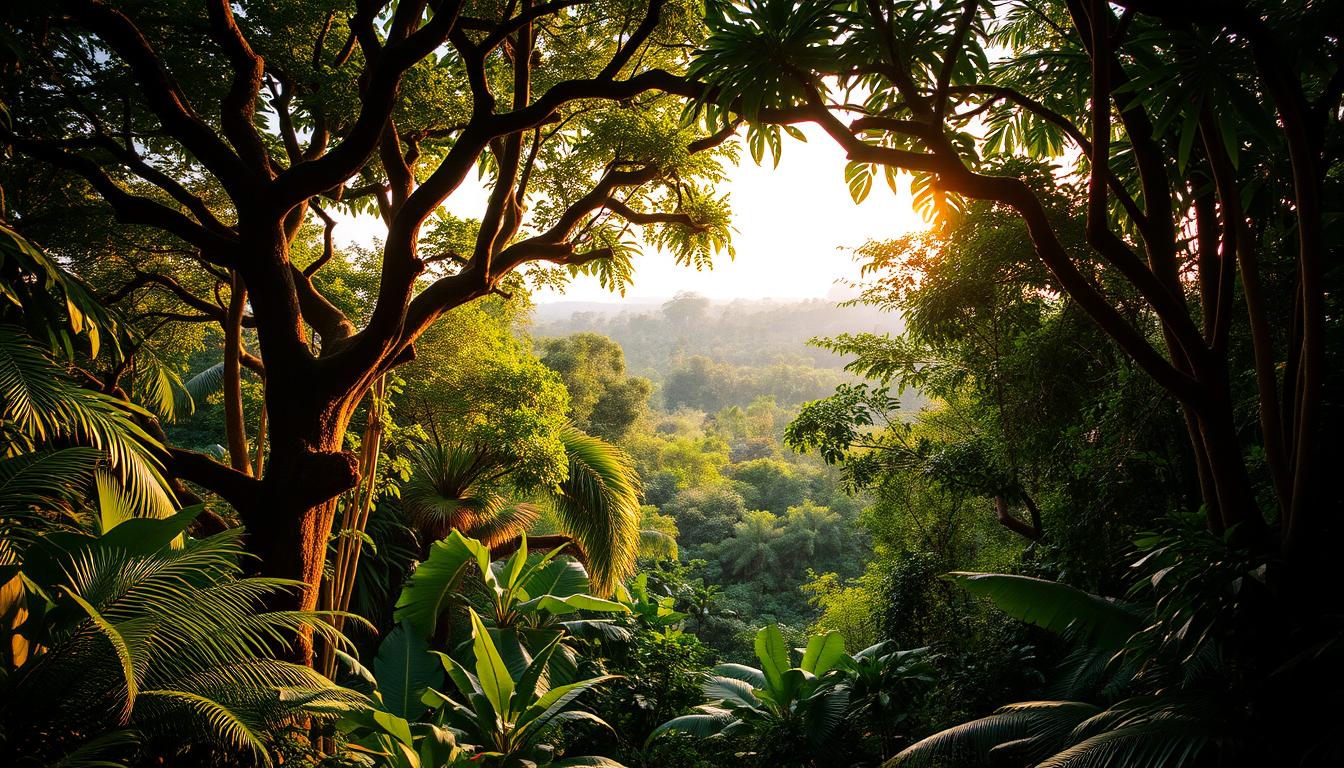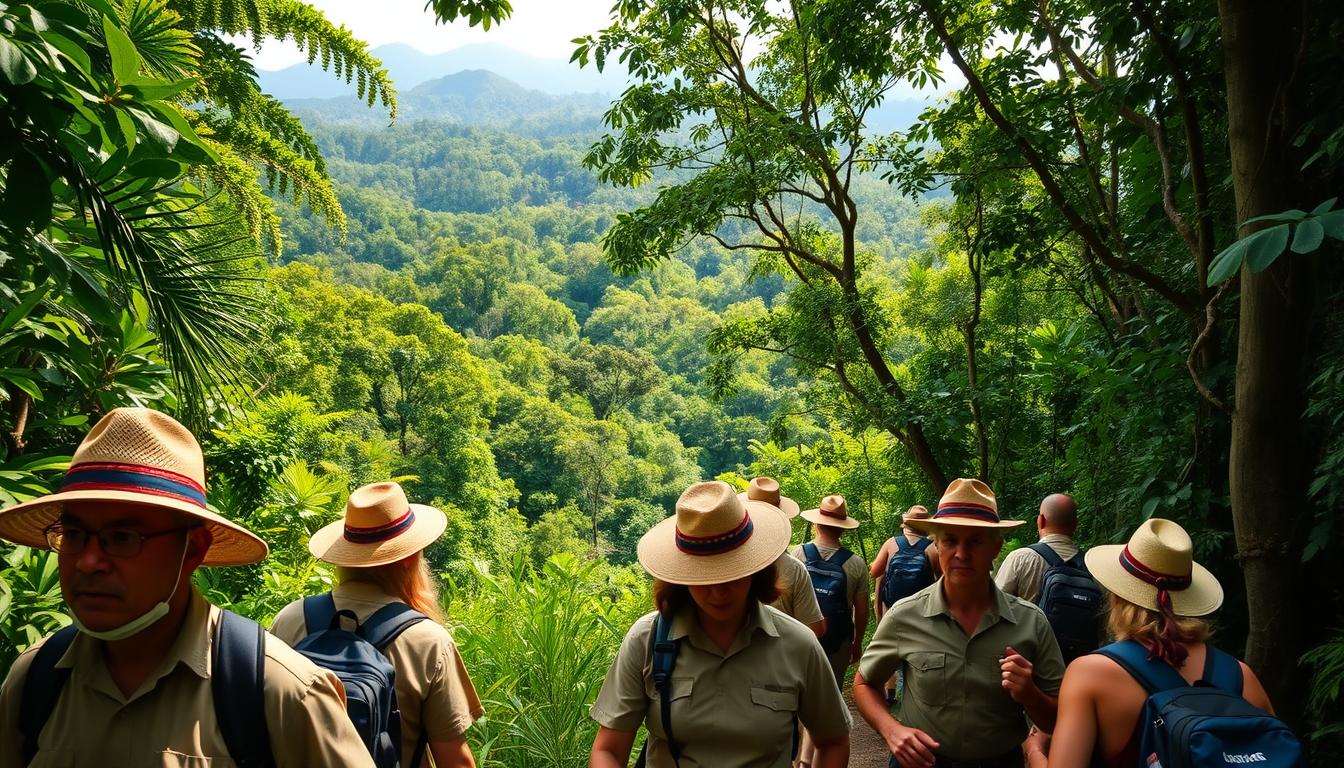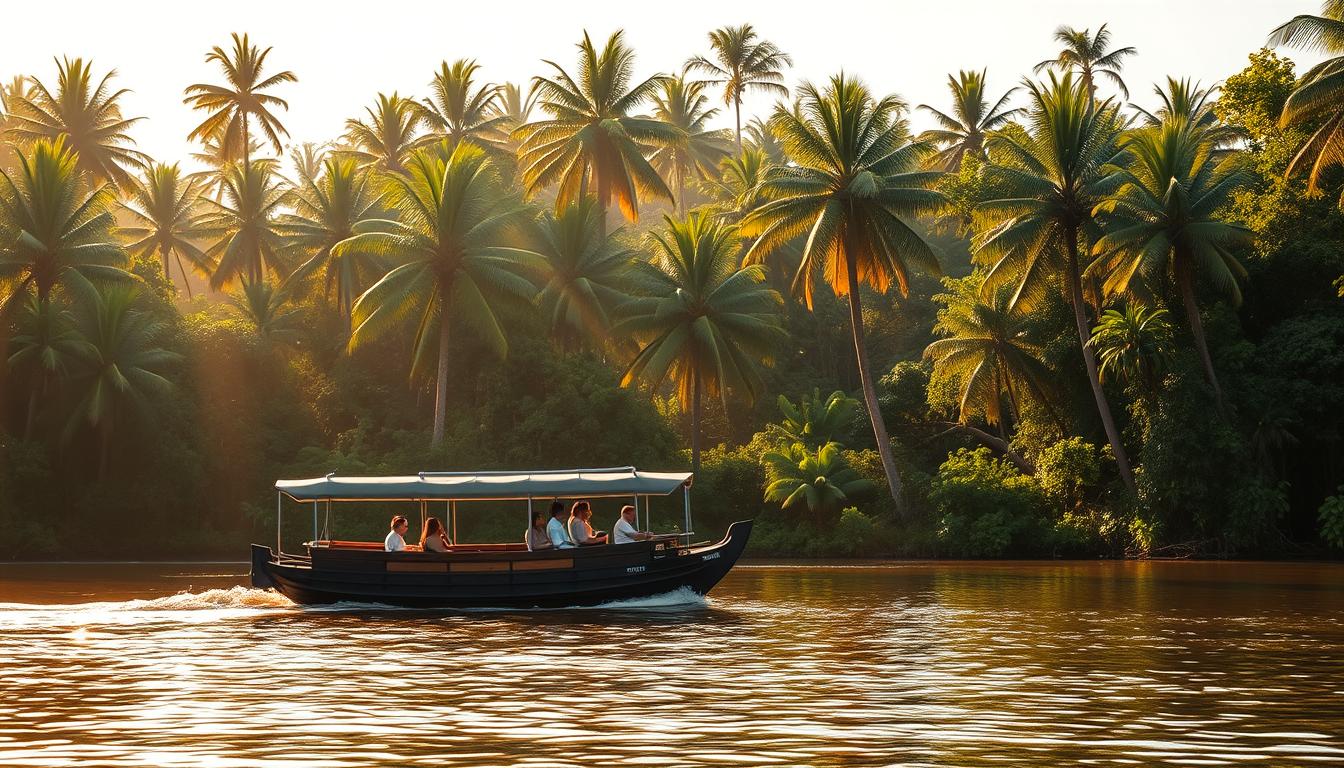As darkness falls over the lush canopy of the rainforest, a world of fascinating creatures emerges. The Amazon, known for its incredible biodiversity, transforms into a realm of mystery and wonder after sunset.
Nighttime in the Amazon is a time of heightened activity for many of its inhabitants. Nocturnal animals in the amazon, such as jaguars, owls, and kinkajous, begin their hunt under the cover of darkness, utilizing their unique adaptations to navigate and thrive in this unique environment.
By unveiling the secrets of this nocturnal world, we gain a deeper understanding of the complex interactions within the ecosystem and the remarkable creatures that call it home.
Key Takeaways
- The Amazon rainforest is home to a diverse array of nocturnal creatures.
- Nocturnal animals have adapted unique survival strategies.
- The nighttime ecosystem is crucial for the rainforest’s biodiversity.
- Understanding nocturnal behavior can provide insights into conservation.
- The Amazon’s nocturnal world is a fascinating and largely unexplored frontier.
The Amazon at Night: What Comes Alive After Sunset
The Amazon rainforest, known for its rich biodiversity, reveals a whole new dimension after dark. As the sun dips below the horizon, the forest undergoes a dramatic transformation, transitioning from a bustling hub of diurnal activity to a vibrant, nocturnal ecosystem.
The Dramatic Transition from Day to Night
The shift from day to night in the Amazon is not just a change in lighting; it’s a complete overhaul of the ecosystem’s dynamics. Nocturnal creatures, adapted to the cover of darkness, begin to emerge, taking advantage of the shadows to hunt, mate, and survive. This transition is marked by a significant change in the soundscape, with the chirping of birds and chattering of monkeys giving way to the hooting of owls and the rustling of leaves as unknown creatures scurry by.

Overview of Nocturnal Biodiversity
The Amazon is home to an astonishing array of nocturnal wildlife, including predators, prey, and everything in between. Some of the fascinating creatures that come alive after sunset include:
- Mammals: Jaguars, ocelots, and kinkajous are just a few examples of mammals that roam the forest at night.
- Reptiles and Amphibians: Snakes, caimans, and frogs are among the many reptiles and amphibians that thrive in the Amazon’s nocturnal environment.
- Insects: The Amazon is renowned for its incredible insect life, with countless species of moths, beetles, and other insects active at night.
This rich biodiversity is a testament to the Amazon’s status as one of the most ecologically diverse regions on the planet. As night falls, the Amazon transforms into a vibrant, nocturnal world, full of life and activity.
Nocturnal Predators of the Amazon Rainforest
The Amazon rainforest transforms into a realm of nocturnal predators after sunset, where big cats and stealthy reptiles rule the night. This transformation is a testament to the rainforest’s incredible biodiversity and the adaptability of its inhabitants.
Big Cats and Mammals on the Prowl
The Amazon is home to some of the most majestic and powerful nocturnal predators in the world. Among these are the big cats, which play a crucial role in maintaining the ecological balance.
Jaguars: The Apex Night Hunters
Jaguars are the largest cats in the Americas and are renowned for their strength and stealth. These apex predators roam the forest floor at night, using their powerful senses to stalk their prey. Their ability to adapt to the nocturnal environment makes them one of the most successful hunters in the Amazon.
Key characteristics of jaguars include:
- Exceptional night vision
- Powerful jaws capable of crushing turtle shells
- A stealthy approach to hunting, often using ambush tactics
Ocelots and Other Smaller Felines
Ocelots and other smaller felines are also nocturnal predators that thrive in the Amazon. These agile and nimble cats are adept at navigating the dense underbrush, making them effective hunters in the dark.
Ocelots are known for their distinctive spotted coats and their ability to climb trees, allowing them to hunt a variety of prey, from rodents to birds.
Stealthy Reptiles and Amphibians
Beyond the big cats, the Amazon is also home to a variety of stealthy reptiles and amphibians that are active at night. These creatures have evolved remarkable adaptations to hunt and survive in the dark.
Caiman and Nocturnal Snakes
Caiman, relatives of alligators, are nocturnal predators that lie in wait for unsuspecting prey in the water. Nocturnal snakes, such as the boa constrictor, are also prevalent, using their heat-sensing abilities to locate warm-blooded prey.
Some common nocturnal snakes in the Amazon include:
- Boa constrictors
- Anacondas
- Fer-de-lance

Tree frogs are another group of nocturnal creatures that come alive after dark. Their calls fill the air as they mate and defend their territories, creating a symphony of sounds that are characteristic of the Amazon night.
The diverse range of tree frogs in the Amazon, with their varied colors and calls, adds to the richness of the rainforest’s nocturnal ecosystem.
The Unseen World of Nocturnal Insects and Arachnids
In the Amazon’s nocturnal world, insects and arachnids exhibit remarkable adaptations, from bioluminescence to complex social behaviors. This hidden realm is teeming with life, as creatures that are rarely seen during the day emerge to thrive in the darkness.
Bioluminescent Creatures
One of the most enchanting aspects of the Amazon’s nocturnal insects is their ability to produce light. Bioluminescent creatures like fireflies and certain beetles use this ability to communicate, attract prey, or defend against predators.
Fireflies and Glowing Beetles
Fireflies, with their flashing lights, are a classic example of bioluminescence. These insects use their light displays to attract mates or signal danger. Similarly, glowing beetles emit a bright light, often as a warning to potential predators.

Night-Active Spiders and Arthropods
Beyond bioluminescence, the Amazon is home to a variety of night-active spiders and arthropods. These creatures have evolved unique strategies to hunt and survive in the dark.
Tarantulas and Scorpions
Tarantulas and scorpions are among the most fascinating nocturnal arachnids. Tarantulas use their webs and powerful legs to capture prey, while scorpions rely on their venomous stingers. Both are crucial components of the Amazon’s nocturnal ecosystem.
| Nocturnal Creature | Adaptation | Ecological Role |
|---|---|---|
| Fireflies | Bioluminescence | Mating and warning signals |
| Tarantulas | Web-building | Predation and population control |
| Scorpions | Venomous stingers | Predation and defense |
The Amazon’s nocturnal insects and arachnids are a testament to the region’s incredible biodiversity. By studying these creatures, we gain insights into the complex interactions within ecosystems and the remarkable adaptations that have evolved to thrive in the dark.
The Symphony of Amazon Night Sounds
The Amazon rainforest transforms into a vibrant soundscape at night, filled with a diverse array of creatures. This nocturnal symphony is not just a collection of random sounds; it’s a complex, dynamic interplay of voices from various species, each playing their part in the ecological balance of the rainforest.
Insect Choruses and Their Ecological Significance
Insects are a crucial component of the Amazon’s night sounds. Certain species of crickets and cicadas produce loud, synchronized calls to attract mates or defend territories. These choruses are not just melodious; they play a significant role in the ecosystem. For instance, the synchronized calling can overwhelm predators, providing a form of protection for the insects.
Ecological significance of insect choruses:
- Mating and attracting partners
- Territorial defense
- Warning calls for predators
Nocturnal Bird and Mammal Calls
Nocturnal birds and mammals add their unique voices to the Amazon’s night soundscape. Owls and nightjars are among the birds that contribute haunting calls, while howler monkeys and bats use vocalizations to communicate.
Owls and Nightjars
Owls and nightjars are nocturnal birds known for their distinctive calls. Owls use their calls to locate prey and communicate with other owls, while nightjars produce a variety of sounds, including churring and whistling calls, to attract mates or deter rivals.
Howler Monkeys and Bat Communications
Howler monkeys are renowned for their loud, deep calls, which can be heard over long distances. These vocalizations are crucial for territorial defense and social bonding within the group. Bats, on the other hand, use a range of calls for echolocation and communication, helping them navigate and hunt in the dark.
The complex interactions between these species create a rich tapestry of sound that is both fascinating and essential to the Amazon ecosystem.
| Species | Type of Call | Purpose |
|---|---|---|
| Crickets/Cicadas | Synchronized calling | Mating, territorial defense |
| Owls | Hooting | Locating prey, communication |
| Nightjars | Churring, whistling | Attracting mates, deterring rivals |
| Howler Monkeys | Loud, deep calls | Territorial defense, social bonding |
| Bats | Echolocation calls | Navigation, hunting |

Exploring the Amazon After Dark: Visitor Experiences
The Amazon rainforest transforms dramatically after dark, presenting a unique opportunity for visitors to witness its nocturnal wildlife up close. As the sun sets, the forest comes alive with a myriad of sounds and movements, offering an experience that is both thrilling and unforgettable.
Night Tours and Guided Expeditions
For those looking to explore the Amazon after dark, night tours and guided expeditions are a must. Expert guides lead visitors through the rainforest, pointing out nocturnal creatures that are often hidden from view during the day. These tours not only provide a chance to see unique wildlife but also offer insights into the ecological significance of the Amazon’s nocturnal biodiversity.
What to Expect on a Night Safari
On a night safari, visitors can expect to encounter a variety of nocturnal animals, from kinkajous and olingo to snakes and spiders. Guides use specialized equipment, such as spotlights, to locate animals in the dark. The experience is both exhilarating and educational, with guides providing information on the behavior and habitat of the creatures encountered.
- Spotlighting nocturnal animals in their natural habitat
- Learning about the unique adaptations of night creatures
- Exploring the rainforest at night with expert guides
Photography Tips for Nocturnal Wildlife
Capturing the beauty of the Amazon’s nocturnal wildlife requires the right photography techniques and equipment. Here are some tips for taking stunning photos on your night safari:
- Use a camera with good low-light performance
- Bring a tripod to stabilize your camera in the dark
- Experiment with different exposure settings to capture the night scene
Equipment and Techniques for Night Photography
Night photography in the Amazon requires specialized equipment and techniques. A camera with manual controls and a wide-aperture lens is ideal for capturing the night scene. Additionally, understanding how to work with the available light and using flash wisely can enhance your photos.
| Equipment | Description | Usefulness |
|---|---|---|
| Camera with manual controls | Allows for adjustments in exposure and aperture | High |
| Wide-aperture lens | Lets in more light for better low-light shots | High |
| Tripod | Stabilizes the camera for sharper images | High |

By following these tips and using the right equipment, you can capture the magic of the Amazon’s nocturnal world. Whether you’re a seasoned photographer or just starting out, the experience of photographing the Amazon’s night creatures is sure to be a highlight of your visit.
Conclusion: Preserving the Magic of the Nocturnal Amazon
The Amazon rainforest is a true natural wonder, with its nocturnal creatures and complex interactions between species making it a fascinating and dynamic place. As we explore the Amazon after dark, we gain a deeper appreciation for the jungle’s nightlife and the importance of preserving the Amazon for future generations.
The nocturnal Amazon is facing numerous threats, from deforestation to climate change, which can have devastating impacts on the delicate balance of the ecosystem. It is essential to support conservation efforts to protect the Amazon rainforest and its incredible nightlife.
By working together to preserve this incredible resource, we can ensure that the magic of the jungle after dark continues to inspire and captivate us for years to come. The Amazon’s amazon rainforest nightlife is a treasure that requires our protection and care.




